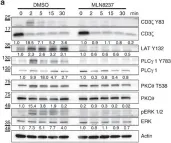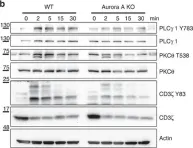The athlete's paradox states that intramyocellular triglyceride accumulation associates with insulin resistance in sedentary but not in endurance-trained humans. Underlying mechanisms and the role of muscle lipid distribution and composition on glucose metabolism remain unclear. We compared highly trained athletes (ATHL) with sedentary normal weight (LEAN) and overweight-to-obese (OVWE) male and female individuals. This observational study found that ATHL show higher insulin sensitivity, muscle mitochondrial content, and capacity, but lower activation of novel protein kinase C (nPKC) isoforms, despite higher diacylglycerol concentrations. Notably, sedentary but insulin sensitive OVWE feature lower plasma membrane-to-mitochondria sn-1,2-diacylglycerol ratios. In ATHL, calpain-2, which cleaves nPKC, negatively associates with PKCε activation and positively with insulin sensitivity along with higher GLUT4 and hexokinase II content. These findings contribute to explaining the athletes' paradox by demonstrating lower nPKC activation, increased calpain, and mitochondrial partitioning of bioactive diacylglycerols, the latter further identifying an obesity subtype with increased insulin sensitivity (NCT03314714).
Product Citations: 15
In Science Advances on 3 January 2025 by Pesta, D. H., Anadol-Schmitz, E., et al.
-
Homo sapiens (Human)
-
Endocrinology and Physiology
In Frontiers in Immunology on 28 March 2023 by Anto, N. P., Muraleedharan, A., et al.
Protein kinase C-θ (PKCθ) is a member of the novel PKC subfamily known for its selective and predominant expression in T lymphocytes where it regulates essential functions required for T cell activation and proliferation. Our previous studies provided a mechanistic explanation for the recruitment of PKCθ to the center of the immunological synapse (IS) by demonstrating that a proline-rich (PR) motif within the V3 region in the regulatory domain of PKCθ is necessary and sufficient for PKCθ IS localization and function. Herein, we highlight the importance of Thr335-Pro residue in the PR motif, the phosphorylation of which is key in the activation of PKCθ and its subsequent IS localization. We demonstrate that the phospho-Thr335-Pro motif serves as a putative binding site for the peptidyl-prolyl cis-trans isomerase (PPIase), Pin1, an enzyme that specifically recognizes peptide bonds at phospho-Ser/Thr-Pro motifs. Binding assays revealed that mutagenesis of PKCθ-Thr335-to-Ala abolished the ability of PKCθ to interact with Pin1, while Thr335 replacement by a Glu phosphomimetic, restored PKCθ binding to Pin1, suggesting that Pin1-PKCθ association is contingent upon the phosphorylation of the PKCθ-Thr335-Pro motif. Similarly, the Pin1 mutant, R17A, failed to associate with PKCθ, suggesting that the integrity of the Pin1 N-terminal WW domain is a requisite for Pin1-PKCθ interaction. In silico docking studies underpinned the role of critical residues in the Pin1-WW domain and the PKCθ phospho-Thr335-Pro motif, to form a stable interaction between Pin1 and PKCθ. Furthermore, TCR crosslinking in human Jurkat T cells and C57BL/6J mouse-derived splenic T cells promoted a rapid and transient formation of Pin1-PKCθ complexes, which followed a T cell activation-dependent temporal kinetic, suggesting a role for Pin1 in PKCθ-dependent early activation events in TCR-triggered T cells. PPIases that belong to other subfamilies, i.e., cyclophilin A or FK506-binding protein, failed to associate with PKCθ, indicating the specificity of the Pin1-PKCθ association. Fluorescent cell staining and imaging analyses demonstrated that TCR/CD3 triggering promotes the colocalization of PKCθ and Pin1 at the cell membrane. Furthermore, interaction of influenza hemagglutinin peptide (HA307-319)-specific T cells with antigen-fed antigen presenting cells (APCs) led to colocalization of PKCθ and Pin1 at the center of the IS. Together, we point to an uncovered function for the Thr335-Pro motif within the PKCθ-V3 regulatory domain to serve as a priming site for its activation upon phosphorylation and highlight its tenability to serve as a regulatory site for the Pin1 cis-trans isomerase.
Copyright © 2023 Anto, Muraleedharan, Nath, Sun, Keasar, Livneh, Braiman, Altman, Kong and Isakov.
-
Immunology and Microbiology
Dietary palmitate and oleate differently modulate insulin sensitivity in human skeletal muscle.
In Diabetologia on 1 February 2022 by Sarabhai, T., Koliaki, C., et al.
Energy-dense nutrition generally induces insulin resistance, but dietary composition may differently affect glucose metabolism. This study investigated initial effects of monounsaturated vs saturated lipid meals on basal and insulin-stimulated myocellular glucose metabolism and insulin signalling.
In a randomised crossover study, 16 lean metabolically healthy volunteers received single meals containing safflower oil (SAF), palm oil (PAL) or vehicle (VCL). Whole-body glucose metabolism was assessed from glucose disposal (Rd) before and during hyperinsulinaemic-euglycaemic clamps with D-[6,6-2H2]glucose. In serial skeletal muscle biopsies, subcellular lipid metabolites and insulin signalling were measured before and after meals.
SAF and PAL raised plasma oleate, but only PAL significantly increased plasma palmitate concentrations. SAF and PAL increased myocellular diacylglycerol and activated protein kinase C (PKC) isoform θ (p < 0.05) but only PAL activated PKCɛ. Moreover, PAL led to increased myocellular ceramides along with stimulated PKCζ translocation (p < 0.05 vs SAF). During clamp, SAF and PAL both decreased insulin-stimulated Rd (p < 0.05 vs VCL), but non-oxidative glucose disposal was lower after PAL compared with SAF (p < 0.05). Muscle serine1101-phosphorylation of IRS-1 was increased upon SAF and PAL consumption (p < 0.05), whereas PAL decreased serine473-phosphorylation of Akt more than SAF (p < 0.05).
Lipid-induced myocellular insulin resistance is likely more pronounced with palmitate than with oleate and is associated with PKC isoforms activation and inhibitory insulin signalling.
ClinicalTrials.gov .NCT01736202.
German Federal Ministry of Health, Ministry of Culture and Science of the State North Rhine-Westphalia, German Federal Ministry of Education and Research, European Regional Development Fund, German Research Foundation, German Center for Diabetes Research.
© 2021. The Author(s).
-
WB
-
Homo sapiens (Human)
-
Endocrinology and Physiology
In Cancer Letters on 1 February 2022 by Chadelle, L., Liu, J., et al.
The cytoskeleton and cell-matrix adhesions constitute a dynamic network that controls cellular behavior during development and cancer. The Focal Adhesion Kinase (FAK) is a central actor of these cell dynamics, promoting cell-matrix adhesion turnover and active membrane fluctuations. However, the initial steps leading to FAK activation and subsequent promotion of cell dynamics remain elusive. Here, we report that the serine/threonine kinase PKCθ participates in the initial steps of FAK activation. PKCθ, which is strongly expressed in aggressive human breast cancers, controls the dynamics of cell-matrix adhesions and active protrusions through direct FAK activation, thereby promoting cell invasion and lung metastases. Using various tools for in vitro and live cell studies, we precisely decipher the molecular mechanisms of FAK activation. PKCθ directly interacts with the FAK FERM domain to open FAK conformation through PKCθ's specific V3 domain, while phosphorylating FAK at newly identified serine/threonine residues within nascent adhesions, inducing cell dynamics and aggressive behavior. This study thus places PKCθ-directed FAK opening and phosphorylations as an original mechanism controlling dynamic, migratory, and invasive abilities of aggressive breast cancer cells, further strengthening the emerging oncogenic function of PKCθ.
Copyright © 2021 Elsevier B.V. All rights reserved.
-
Cancer Research
In Science Advances on 8 October 2021 by Apostolopoulou, M., Mastrototaro, L., et al.
High-intensity interval training (HIIT) improves cardiorespiratory fitness (VO2max), but its impact on metabolism remains unclear. We hypothesized that 12-week HIIT increases insulin sensitivity in males with or without type 2 diabetes [T2D and NDM (nondiabetic humans)]. However, despite identically higher VO2max, mainly insulin-resistant (IR) persons (T2D and IR NDM) showed distinct alterations of circulating small extracellular vesicles (SEVs) along with lower inhibitory metabolic (protein kinase Cε activity) or inflammatory (nuclear factor κB) signaling in muscle of T2D or IR NDM, respectively. This is related to the specific alterations in SEV proteome reflecting down-regulation of the phospholipase C pathway (T2D) and up-regulated antioxidant capacity (IR NDM). Thus, SEV cargo may contribute to modulating the individual metabolic responsiveness to exercise training in humans.
-
WB
-
Homo sapiens (Human)
-
Biochemistry and Molecular biology
-
Cell Biology
-
Endocrinology and Physiology
In Nat Commun on 19 April 2016 by Blas-Rus, N., Bustos-Morán, E., et al.
Fig.8.A

-
WB
-
Mus musculus (House mouse)
Collected and cropped from Nat Commun by CiteAb, provided under a CC-BY license
Image 1 of 2
In Nat Commun on 19 April 2016 by Blas-Rus, N., Bustos-Morán, E., et al.
Fig.8.B

-
WB
-
Mus musculus (House mouse)
Collected and cropped from Nat Commun by CiteAb, provided under a CC-BY license
Image 1 of 2

